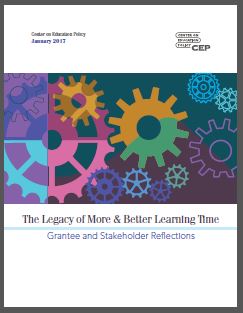

January 27, 2017
 Expanding instructional time to help boost student performance and improve low-performing schools has been at the forefront of many reform efforts over the past five years. Former education secretary Arne Duncan was a strong advocate for “more and better learning time,” and saw it as a way to help level the playing field for low-income students who often have less access to high-quality instruction in school and enrichment activities before and after school. Under Duncan’s leadership, the U.S. Department of Education incentivized low-performing schools across the nation to expand learning time with both the School Improvement Grant (SIG) program and the federal No Child Left Behind (NCLB) waiver.
Expanding instructional time to help boost student performance and improve low-performing schools has been at the forefront of many reform efforts over the past five years. Former education secretary Arne Duncan was a strong advocate for “more and better learning time,” and saw it as a way to help level the playing field for low-income students who often have less access to high-quality instruction in school and enrichment activities before and after school. Under Duncan’s leadership, the U.S. Department of Education incentivized low-performing schools across the nation to expand learning time with both the School Improvement Grant (SIG) program and the federal No Child Left Behind (NCLB) waiver.
But expanding learning time, like any school improvement effort, is hard work and simply adding more of the same instruction or activities will not likely yield any improvements. To better understand the challenges and potential benefits of expanded learning time, the Center on Education Policy (CEP) at George Washington University, studied the work of The Ford Foundation’s More and Better Learning Time (MBLT) grantees. CEP talked to 60 organizations and schools that participated in the foundation’s MBLT initiative from 2011-2015. Using both survey and case study research methods, CEP studied the work of those organizations that operated “on the ground,” supporting schools, districts and other organizations as they built capacity and implanted MBLT strategies; researchers that studied MBLT efforts; advocates and others who promoted and built community support for MBLT; and members of the media who reported on or documented MBLT efforts. In-depth case studies were conducted in three cites: Denver, Rochester and Los Angeles. What we learned was captured in a recently released report, The Legacy of More & Better Learning Time: Grantee and Stakeholder Reflections.
Schools and districts engage in MBLT activities in a variety of ways, and while MBLT can have a positive impact on students and schools, the success of such efforts depends on having the right conditions in place. We found that successful MBLT efforts shared some common characteristics:
Leadership
Most of the grantees we spoke with agreed that if the principal and/or district leadership were not working together to mutually support and drive the effort, the quality of the outcomes would suffer.
Supportive Stakeholders
Leadership at the school and district level was not enough. Parents, teachers, community groups and other important local leaders also need to be engaged.
Collaboration
Effective collaboration with community groups that understand the local population and are trusted can help build and maintain support for MBLT, especially when the going gets rough.
Planning Time
Most MBLT initiatives have many moving parts. Ample planning time at the outset is needed to ensure there is buy-in from key stakeholders and structure to organize the different organizations and people involved.
Dedicated Funding
Dedicated and sustainable funding was identified as the most important factor and the biggest challenge for MBLT grantees. Short-term grants can provide a welcome influx of funds but make long-term planning more difficult.
Wiggle Room
MBLT efforts often face systemic obstacles. In each community, the dynamic around these obstacles is different. Having the flexibility to develop creative workarounds to obstacles was an important asset for many grantees.
Many of the lessons learned that were identified in the report echo other school improvement initiatives, and despite facing some especially hard challenges regarding reliable funding and systemic obstacles, many grantees said that MBLT made a positive contribution to improving student performance, strengthening classroom instruction, improving school culture and climate, and engaging families.
Perhaps the most positive thing to come from the Ford Foundation’s MBLT initiative, however, is that successful MBLT efforts can spread systemically from school to school, district to district and state to state. Indeed many of the grantees featured in this report were inspired to implement MBLT because of what they saw working in other communities. This particular finding shows that sometimes it really is best to lead by example. To access the new report and CEP’s 2015 report on expanded learning time, go to http://www.cep-dc.org.